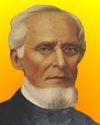
On 19 Aug 1856, Gail Borden was issued a U.S. Patent for his process of making condensed milk. His product was important, because condensed milk could be preserved for long periods of storage, and in this form milk became more readily available in large cities than had been possible before.
His company’s advertising slogan “The milk from contented cows” was one of the great American advertising campaigns. The Borden company is today one of the largest dairy product concerns in the world.
Not only is the familiar Borden condensed milk named after the real person who founded the company, but Elsie the iconic cartoon cow on the label was modelled on a real cow (though named Lobelia), selected from a group of bovine beauties that represented the Borden company at the 1939 World’s Fair.
A page of links to articles and patent descriptions for Gail Borden and his Inventions, includes more than his famous milk product. His first invention was a meat biscuit that preserved meat extracts in a form for travellers and sailors, that not only kept in good condition for longer periods of time than fresh meat, but also reduced the size of a month's provisions to fit a small container.

On 19 Aug 1968, George Gamow died, a Russian-born American nuclear physicist, cosmologist and writer who was one of the foremost advocates of the big-bang theory. His legacy includes a classic whimsical, but scientifically based, classic book in which he introduces a clear explanation of the central concepts in modern physics, through the fantastic adventures of a bank clerk Today's book pick is: Mr. Tompkins in Paperback, by George Gamow, which reprints jointly the Adventures of Mr Tompkins in Wonderland and Mr Tompkins Explores the Atom. This entertaining book is a gem of writing that has captivated the imagination of generations of readers. For example, Mr Tompkins illustrates the result of being in a room where the speed of light has been reduced to 100 mph. It makes the meaning of relativity accessible to students from Year 9 and up, and will still hold the interest of a graduate student, or a lay reader interested in science. This reprint includes a new foreword to shed light from the current developments in physics today. Your webmaster read Gamow's books more years ago than is willing to admit to, and they remain memorable. If somehow you haven't read it yet, it's time it was a favorite on your bookshelf!
It is available from Amazon, typically about New from $6.17. Used from $1.11. (As of earlier time of writing - subject to change.)
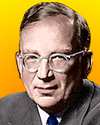 | It took less than an hour to make the atoms, a few hundred million years to make the stars and planets, but five billion years to make man! |
 | La puissance des mouches. Elles gagnent des batailles, empêchent notre âme d’agir, mangent notre corps. Flies are so mighty that they win battles, paralyse our minds, eat up our bodies. |
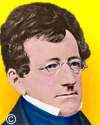 | Botany,—the science of the vegetable kingdom, is one of the most attractive, most useful, and most extensive departments of human knowledge. It is, above every other, the science of beauty. |
 | I think if we had not repaired the telescope, it would have been the end of the space station, because space station requires a huge number of space walks. I think it was fair to use the Hubble space telescope as a test case for space walks, to say, “Can NASA really do what they say they can do up there?” |
| Before you look at today's web page, see if you can answer some of these questions about the events that happened on this day. Some of the names are very familiar. Others will likely stump you. Tickle your curiosity with these questions, then check your answers on today's web page. | |
| Births | |
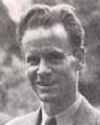 | Philo T. Farnsworth, born 19 Aug 1906, was the co-inventor of the electronic television set. What TV manufacturer was named after him? |
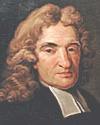 | John Flamsteed, born 19 Aug 1646, was an English astronomer who was one of a group of scientists who convinced King Charles II to build a national observatory. He was appointed the first Astronomer Royal (1675-1719). Which national observatory did he help establish? |
| Deaths | |
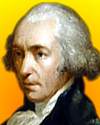 | A Scottish engineer invented the first type of stationary steam engine with the important improvement of a separate steam condenser. He died near Birmingham, England, on 19 Aug 1819. Can you name this man? |
 | Blaise Pascal (1623-1662) was a French mathematician, physicist and child prodigy. He invented the first digital calculator to help his father with his work collecting taxes. Which of the following did he also accomplish? Theory of probabilities; Law of pressure; Invented the hydraulic press. |
| Events | |
 | On 19 Aug 1960, Sputnik 5 was launched into space and was later retrieved with its live animal passengers. What animals were these, first to be retrieved after a space journey? |
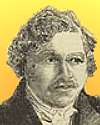 | On 19 Aug 1839, the first process to allow an image to be chemically fixed as a permanent picture was announced. What is the name of this photographic process? |
Fast answers for the previous newsletter for August 18: Cuba • William Siemens • paper chromatography • 3000 feet • the decade including 1891 • helium.
 If you enjoy this newsletter, the website, or wish to offer encouragement or ideas, please send feedback by using your mail reader Reply button.
If you enjoy this newsletter, the website, or wish to offer encouragement or ideas, please send feedback by using your mail reader Reply button. Your click on a Facebook, StumbleUpon, or other social button on the site webpages is also a welcome sign of appreciation. Thank you for using them.
© This newsletter is copyright 2020 by todayinsci.com. Please respect the Webmaster's wishes and do not put copies online of the Newsletter — or any Today in Science History webpage. (If you already have done so, please remove them. Thank you.) Offline use in education is encouraged such as a printout on a bulletin board, or projected for classroom viewing. Online, descriptive links to our pages are welcomed, as these will provide a reader with the most recent revisions, additions and/or corrections of a webpage. For any other copyright questions, please contact the Webmaster by using your mail reader Reply button.
--
If you do not want to receive any more newsletters, Unsubscribe
To update your preferences and to unsubscribe visit this link
Executive Real Estate Business Class
-
"It was like a man with wings. It wasn't like anything you'd see on TV or in a monster movie." ...
About the publisher
Search This Blog
Blog Archive
-
▼
2020
(1542)
-
▼
August
(192)
- HISTORY: Lessons from the latest March on Washington
- New This Week on History News Network
- Discover lost cities with Nat Geo History. Subscri...
- On This Day for August 31 - Confederates evacuated...
- Newsletter for Monday 31 August.
- Face Masks Make you dumb (compliant) Economic des...
- August 31: Malaya Gains independence, Princess Dia...
- FAMILY: How to get your kid to wear a mask
- Roman numerals | Ancient empires | The battle of C...
- On This Day for August 30 - Historic spaceflight b...
- Newsletter for Sunday 30 August.
- August 30: Crossbow Outlawed, Nehru Requests Indep...
- The Compass: London
- On This Day for August 29 - New Orleans hit by Hur...
- Newsletter for Saturday 29 August.
- August 29: Treaty of Nanking, Second Battle of Bul...
- CORONAVIRUS UPDATE: These promising treatments are...
- PHOTOGRAPHY: Lives that matter, from the pietà to ...
- The Horrifying True Story Behind "Candyman," The Y...
- The Roundup Top Ten from History News Network
- On This Day for August 28 - Civil rights march on ...
- Newsletter for Friday 28 August.
- August 28: Tom Thumb Races a Horse, Scientific Ame...
- ANIMALS: When baby wombats become your roommates
- Give your kids the world! Subscribe now.
- Create remote resiliency with Britannica Kids
- On This Day for August 27 - The death of Titian, M...
- Newsletter for Thursday 27 August.
- Lockdown for you but not for the politically corre...
- August 27: Krakatoa Erupts and the End of Lord Mou...
- YOUR WEEKLY ESCAPE: Inside the world of transhuman...
- SCIENCE: Behind the hurricanes, wildfires, and bla...
- Demystified: What Does Gaslighting Mean?
- The Latest News from History News Network
- On This Day for August 26 - Joan of Arc's arrival ...
- Newsletter for Wednesday 26 August.
- Fear fatigue is more dangerous than COVID-19 plus
- August 26: Longbows, Cannons and Morris Mini-Minors
- For Your Eyes Only: America’s Spying Secrets
- 50+ Vintage Pictures Of Your Parents Being Cooler ...
- TRAVEL: Waiting for a silver lining
- On This Day for August 25 - Paris liberated, Sean ...
- Newsletter for Tuesday 25 August.
- August 25: French Arrive in Louisiana, James Cook ...
- HISTORY: Why the U.S. Postal Service matters
- Even Life-Long Learners Need Back-to-School Savings!
- Experience a 360-degree virtual tour of the Nat Ge...
- New This Week From History News Network
- On This Day for August 24 - Eruption of Mount Vesu...
- Newsletter for Monday 24 August.
- GeoEngineering Massive Drought WildFires + More Ma...
- August 24: Alaric I Sacks Rome, British Capture Wa...
- FAMILY: How you can support your kid's teachers—an...
- Genghis Khan | Edward the Confessor | The Spanish ...
- On This Day for August 23 - William Wallace execut...
- Newsletter for Sunday 23 August.
- August 23: 1st US Women's Rights Convention, Bin L...
- The Compass: U.S. National Parks
- On This Day for August 22 - Wars of the Roses ende...
- Newsletter for Saturday 22 August.
- August 22: Wars of the Roses Ends, Chennai Founded...
- CORONAVIRUS UPDATE: Your employer could require yo...
- PHOTOGRAPHY: Capturing a muted Russia
- The Unsung Heroes Who Fought For Women's Voting Ri...
- The Roundup Top Ten from History News Network
- On This Day for August 21 - French defeated at the...
- Newsletter for Friday 21 August.
- YOUR WEEKLY ESCAPE: A million people live in under...
- August 21: Mona Lisa is Stolen, the 50th US State ...
- ANIMALS: Soft and virus-y, the mink with COVID-19
- On This Day for August 20 - Viking 1 launched, Eer...
- Total Exposé! Watch the 2nd Plandemic Movie "InDoc...
- Newsletter for Thursday 20 August.
- August 20: The Dutch East India Company, Sun Yat-s...
- A Champion Will Be Crowned on 'Forged in Fire' Ton...
- SCIENCE: The robots have arrived
- The Latest News from History News Network
- On This Day for August 19 - Attempted coup against...
- Newsletter for Wednesday 19 August.
- August 19: Cease-Fire in the Iran-Iraq War and Gor...
- TRAVEL: Will new tech make flying safer now?
- Sail along with Ancient Explorers w/ Nat Geo History!
- On This Day for August 18 - Nineteenth Amendment r...
- Newsletter for Tuesday 18 August.
- August 18: Wilson's Ill-fated Neutrality, American...
- HISTORY: Breaking 'substantial barriers' with Kama...
- New This Week On History News Network
- On This Day for August 17 - Indonesia's declaratio...
- Newsletter for Monday 17 August.
- State of Tennessee orders Home visit checks on ALL...
- August 17: Division of Korea, Indonesian Independe...
- FAMILY: Preparing for this unusual school year
- Medieval baby names | Attila the Hun | Pederasty i...
- On This Day for August 16 - Leonel Fernández Reyna...
- Newsletter for Sunday 16 August.
- August 16: Deadly Chaos in Calcutta and the Last C...
- The Compass: New Zealand
- On This Day for August 15 - Independence for India...
- Newsletter for Saturday 15 August.
- August 15: The Mayflower Sets Sail, Indian Indepen...
-
▼
August
(192)
-
Blogroll
-
About
HistoryFact










0 comments:
Post a Comment